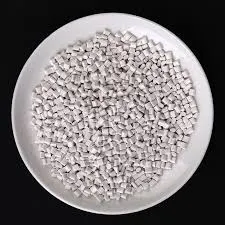Ammonium Thiocyanate Properties, Applications, and Safety
Ammonium thiocyanate (NH4SCN) is an inorganic compound that presents itself as a white, crystalline salt, commonly used in various applications ranging from industrial processes to laboratory experiments. Understanding this compound's properties, uses, and safety measures is essential for anyone working with it or studying its impacts.
Properties of Ammonium Thiocyanate
Ammonium thiocyanate is highly soluble in water and exhibits hygroscopic behavior, which means it can absorb moisture from the environment. This property makes it particularly useful in applications that require moisture retention. The compound has a melting point of approximately 149 °C (300 °F) and decomposes when heated, releasing toxic gases such as ammonia and sulfur oxides. It has a molecular weight of 76.12 g/mol, and the presence of both ammonium and thiocyanate ions explains its unique properties.
The thiocyanate ion (SCN-) serves as a versatile ligand and is involved in various coordination chemistry, making ammonium thiocyanate a subject of interest in chemical research. The salt is also noted for its strong affinity for transition metals, which can lead to the formation of colored complex ions. This property is particularly useful in analytical chemistry, where the detection of certain metals in solution can be achieved through spectroscopic methods.
Applications of Ammonium Thiocyanate
The applications of ammonium thiocyanate are diverse, spanning several fields
1. Analytical Chemistry One of the primary uses of ammonium thiocyanate is in chemical analysis, particularly in the detection of metal ions like iron (III) and silver (I). The compound can form precipitates or colored complexes that can be quantitatively measured.
2. Agriculture Ammonium thiocyanate can play a role in agriculture, especially as a source of nitrogen and sulfur for plants. These elements are essential nutrients that promote healthy growth, and thiocyanate may boost soil quality and fertility when used appropriately.
ammonium thiocyanate

3. Manufacturing In the industrial sector, ammonium thiocyanate is employed in the production of various chemicals. It is used to manufacture certain plastics, pharmaceuticals, and in textile processing. The compound's ability to act as a reactive agent makes it valuable in synthesizing different materials.
4. Cryoscopy Ammonium thiocyanate serves as a cryoscopic agent in freezing point depression experiments, which are vital in studying solutions and their properties. This capability is significant for determining molecular weights of unknown substances.
5. Research In biochemical and analytical laboratories, ammonium thiocyanate can be utilized to study enzyme activity and other physiological processes.
Safety Considerations
While ammonium thiocyanate has various beneficial applications, it must be handled with care due to safety concerns. The compound can be irritating to the skin, eyes, and respiratory system upon contact or inhalation. Therefore, it is crucial to wear appropriate personal protective equipment, such as gloves, goggles, and face masks, when handling it. In case of exposure, affected individuals should seek medical attention, and safety data sheets should be consulted for disposal and spill management procedures.
Furthermore, since ammonium thiocyanate can decompose and release toxic gases when heated, storage in a cool, dry place, away from incompatible materials like strong acids and bases, is essential to minimize risks.
Conclusion
Ammonium thiocyanate is a compound of significant chemical interest due to its versatile applications in various fields, including analytical chemistry, agriculture, and manufacturing. Understanding its properties and safety measures is critical for its effective and safe use. As research continues, the potential applications and benefits of this compound may expand, contributing further to various industrial and scientific advancements.

